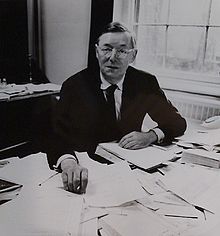art.wikisort.org - Researcher
Sir John Wyndham Pope-Hennessy CBE FBA FSA (13 December 1913 – 31 October 1994), was a British art historian. Pope-Hennessy was Director of the Victoria and Albert Museum between 1967 and 1973, and Director of the British Museum between 1974 and 1976. He was a scholar of Italian Renaissance art. Many of his writings, including the tripartite Introduction to Italian Sculpture, and his magnum opus, Donatello: Sculptor, are regarded as classics in the field.
John Pope-Hennessy CBE | |
|---|---|
 Pope-Hennessy at his desk. | |
| Born | John Wyndham Pope-Hennessy 13 December 1913 London, England |
| Died | 31 October 1994 (aged 80) Florence, Italy |
| Resting place | Cimitero degli Allori, Florence, Italy |
| Nationality | British |
| Alma mater | University of Oxford |
| Occupation | Art historian |
| Parents |
|
| Relatives | John Pope Hennessy (grandfather) James Pope-Hennessy (brother) |
Early years
Born into an Irish Catholic family in the Belgravia district of Central London, Pope-Hennesssy's father was Major-General Richard Pope-Hennessy, who was the son of the politician John Pope Hennessy. Pope Hennessy's mother was Dame Una Pope-Hennessy. He was the elder of two sons; his younger brother, James Pope-Hennessy was a noted writer.
Pope-Hennessy was educated at Downside School, a Catholic boarding school for boys, in Stratton-on-the-Fosse. He then went on to Balliol College at the University of Oxford, where he specialized in modern history. At Oxford, he was introduced by Logan Pearsall Smith, a family friend, to Kenneth Clark, who later became a mentor.
Upon graduation, Pope-Hennessy embarked his journeyman years by traveling in continental Europe and becoming acquainted with art collections, both public and private.
Career

Between 1955 and 1963, Pope-Hennessy's three-volume Introduction to Italian Sculpture was published, covering Gothic, Renaissance and High Renaissance and Baroque sculpture.[1] The following year, he was named Slade Professor of Fine Art at the University of Cambridge.
Pope-Hennessy served as the director of the Victoria and Albert Museum between 1967 and 1973, and then as director of the British Museum from 1974 until 1976. There, he was nicknamed by colleagues as "The Pope".[2]
Traumatized by the murder of his gay brother James in January 1974, Pope-Hennessy left the British Museum after only two years as director.[3] Initially, he went to Tuscany, but was enticed by an offer from the Metropolitan Museum of Art to head its department of European painting, and moved to New York City. He combined this curatorial post with a professorship at New York University's Institute of Fine Arts. Pope-Hennessy was elected to the American Philosophical Society in 1974 and the American Academy of Arts and Sciences in 1978.[4][5] In 1986, Philippe de Montebello, director of the Metropolitan Museum of Art, created the John Pope-Hennessy Curatorship of European Paintings.[6]
Pope-Hennessy also served on the boards of the Venice in Peril Fund and Save Venice Inc., two non-profit organizations dedicated to the conservation and preservation of Venetian cultural heritage.
Death and legacy

Pope-Hennessy retired at the age of seventy-five and moved permanently to Florence with his lover, Michael Mallon, and resided at Palazzo Canigiani, where he died five years later.[7] Pope-Hennessy is buried in the Cimitero degli Allori in Florence. His gravestone includes a quote from the First Epistle to the Corinthians in the Bible.
Selected works
- The Drawings of Domenichino in the Collection of His Majesty the King at Windsor Castle, 1948
- A Lecture on Nicholas Hilliard, 1949
- Introduction to Italian Sculpture (3 vols.), 1955–1963
- Donatello: Sculptor, 1993
- Essays on Italian Sculpture, 1968
- Catalogue of Italian Sculpture in the Victoria and Albert Museum (3 vols.), 1964
See also
- List of directors of the British Museum
References
- "John Pope-Hennessy".
- "John Pope-Hennessy". 29 January 2014.
- "Quite contrary | 2 August 2018 | the Spectator".
- "APS Member History". search.amphilsoc.org. Retrieved 4 August 2022.
- "John Wyndham Pope-Hennessy". American Academy of Arts & Sciences. Retrieved 4 August 2022.
- "B1706413_003".
- "Dictionary of Art Historians". Archived from the original on 30 August 2018. Retrieved 13 March 2019.
External links
- Finding aid for the John Pope-Hennessy Papers at the Getty Research Institute.
На других языках
[de] John Pope-Hennessy
Sir John Wyndham Pope-Hennessy (* 13. Dezember 1913 in London; † 31. Oktober 1994 in Florenz) war ein britischer Kunsthistoriker und Direktor des British Museums in London.- [en] John Pope-Hennessy
Другой контент может иметь иную лицензию. Перед использованием материалов сайта WikiSort.org внимательно изучите правила лицензирования конкретных элементов наполнения сайта.
WikiSort.org - проект по пересортировке и дополнению контента Википедии